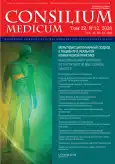Hyperuricemia in patients with stable coronary artery disease and arterial hypertension and percutaneous coronary interventions
- Authors: Mironova O.l.1, Fomin V.V.1
-
Affiliations:
- Sechenov First Moscow State Medical University (Sechenov University)
- Issue: Vol 22, No 12 (2020)
- Pages: 20-22
- Section: Articles
- URL: https://journals.rcsi.science/2075-1753/article/view/95351
- DOI: https://doi.org/10.26442/20751753.2020.12.200555
- ID: 95351
Cite item
Full Text
Abstract
Full Text
##article.viewOnOriginalSite##About the authors
Olga lu. Mironova
Sechenov First Moscow State Medical University (Sechenov University)
Email: mironova_o_yu@staff.sechenov.ru
канд. мед. наук, доц. каф. факультетской терапии Moscow, Russia
Viktor V. Fomin
Sechenov First Moscow State Medical University (Sechenov University)чл.-кор. РАН, д-р мед. наук, проф., проректор по клинической работе и дополнительному профессиональному образованию Moscow, Russia
References
- Чазова И.Е., Жернакова Ю.В., Кисляк О.А. и др. Консенсус по ведению пациентов с гиперурикемией и высоким сердечно-сосудистым риском. Системные гипертензии. 2019; 16 (4): 8-21.
- Чазова И.Е., Шестакова М.В., Жернакова Ю.В. и др. Рекомендации по ведению больных артериальной гипертонией с метаболическими нарушениями и сахарным диабетом 2-го типа. Системные гипертензии. 2020; 17 (1): 7-45.
- Ostermann M, Bellomo R, Burdmann EA et al. Controversies in acute kidney injury: conclusions from a Kidney Disease: Improving Global Outcomes (KDIGO) Conference. Kidney Int 2020; 98 (2): 294-309.
- Миронова О.Ю. Индуцированная контрастными веществами нефропатия. Терапевтический архив. 2013; 85 (6): 90-5.
- KDIGO Working Group. Clinical Practice Guideline for Acute Kidney Injury. Kidney Int Suppl 2012;(1): 124-38. http://www.kdigo.org/clinical_practice_guidelines/pdf/KDIGO AKI Guideline.pdf
- Williams B, Mancia G, De Backer G et al. 2018 Guidelines for the Management of Arterial Hypertension: The Task Force for the Management of Arterial Hypertension of the European Society of Hypertension (ESH) and of the European Society of Cardiology (ESC). J Hypertens 2018; 25 (6): 1105-87.
- Ponikowski P, Voors AA, Anker SD et al. 2016 ESC Guidelines for the diagnosis and treatment of acute and chronic heart failure. Eur Heart J 2016; 37 (27): 2129-200m.
- Dedov II, Shestakova MV, Mayorov AY et al. Standards of specialized diabetes care. Diabetes Mellit 2017; 20 (1S): 1-112.
- Khanna D, Fitzegarld J, Khanna P et al. American College of Rheumatology Guidelines for Management of Gout Part I: Systematic Non-pharmacologic and Pharmacologic Therapeutic Approaches to Hyperuricemia. Arthritis Care Res 2012; 64 (10): 1431-46. http://www.ncbi.nlm.nih.gov/ pubmed/3683400%5Cnhttp://www.pubmedcentral.nih.gov/articlerender.fcgi?artid=PMC368044
- Алиментарные анемии. Доклад научной группы ВОЗ. 1970.
- Kim S-K. Interrelationship of Uric Acid, Gout, and Metabolic Syndrome: Focus on Hypertension, Cardiovascular Disease, and Insulin Resistance. J Rheum Dis 2018; 25 (1): 19.
- Ichida K, Matsuo H, Takada T et al. Decreased extra-renal urate excretion is a common cause of hyperuricemia. Nat Commun 2012; 3: 764-7. doi: 10.1038/ncomms1756
- Abeles AM, Pillinger MH. Gout and cardiovascular disease: crystallized confusion. Curr Opin Rheumatol 2019; 31 (2): 118-24.
Supplementary files






